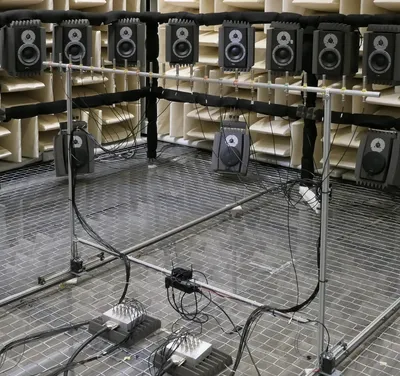Free-field auralization for dynamic scenes in hearing research
Hearing research is increasingly using complex and interactive sound scenes to bring real-life situations into the lab. These sound scenes are auralized over an arrangement of loudspeakers in the free-field (in an anechoic chamber), which removes the need for headphones. This allows us to run experiments with hearing aid wearers, cochlear implant users and normal hearing listeners without changes to the system as they all listen naturally with their own ears or devices.
Evaluation of the usable zone in the loudspeaker array
Since we want to use the loudspeaker array in our anechoic chamber for hearing research, we must be able to precisely control the sound pressure level and the frequency response of the reproduced sound field, and know the resulting interaural cues. Further, the precision of our reproduction should be on par with that of the auditory system, in order to be able to study human hearing. Since listeners will move when they interact with the scene, we are interested in how far off center, where reproduction is best, they are allowed to move. This is why we investigate sound field synthesis using both physical measurements and auditory models, to better understand the shortcomings of the reproduced sound fields and the way they are perceived by a listener.

To measure the sound field reproduced by the loudspeaker array, we developed a linear microphone array that can be driven through the anechoic chamber (figure 1). Figure 2 shows a map of the sound pressure level error inside the loudspeaker array obtained when comparing the theoretical sound field of a 1 kHz point source at 4 m distance and 13° azimuth with the reproduced sound field of a simulated source at that location using a sound field synthesis method known as Higher-Order Ambisonics (HOA). The errors are mostly below 1 dB as indicated by the colour grading (Kuntz, Kolotzek & Seeber, 2021). 1 dB corresponds to the just noticeable difference in level, which means our reproduction accuracy is high enough for hearing research. The region in which we achieve such a low error (indicated by the green circle in the figure) also indicates that we can at least let one participant move a little inside the loudspeaker array.
Interaural cues with sound field synthesis methods
The so-called interaural cues (level and time differences between the ears of a listener) are crucial for spatial hearing and need to be correct for hearing experiments and hearing aid development. The following figure shows the interaural level difference (ILD) a listener could expect at different positions inside the loudspeaker array, again for a simulated source at 4 m distance and 13° azimuth. The dotted line indicates the positions where an ILD of 0 dB is expected. As shown in the figure, there is a shift in the ILD due to the difference between the distance of the loudspeakers and the distance of the simulated source (Kuntz, Seeber, 2021).
The interaural time difference (ITD) is also plausible in its mean value, but shows a lot more variation across time when a listener is not standing in the center of the loudspeaker array. This indicates that the listener can mainly rely on ILDs, which can be problematic for binaural unmasking or speech understanding.
Team members involved
Funding
Funded by TUM and associated with project C5 in SFB 1330, funded by the Deutsche Forschungsgemeinschaft (DFG, German Research Foundation) – Projektnummer 352015383. The rtSOFE system was funded by BMBF 01 GQ 1004B.
Selected publications
Kuntz, M.; Kolotzek, N.; Seeber, B.U.: Gemessener Schalldruckpegel im Lautsprecherarray für verschiedene Schallfeldsyntheseverfahren. Fortschritte der Akustik - DAGA '21, 2021 [mehr…] [Volltext (mediaTUM)]
Kuntz, M.; Seeber, B. U.: Sound field synthesis: Simulation and evaluation of auralized interaural cues over an extended area. Proceedings of the Euronoise 2021 Conference, 2021 [mehr…] [Volltext (mediaTUM)]
Kuntz, M.; Seeber, B.U.: Wiedergabe von Schallfeldern: Analyse der interauralen Merkmale. Fortschritte der Akustik -- DAGA '20, 2020, 9-12 [mehr…] [Volltext (mediaTUM)]
Seeber, B.; Hafter, E.: Perceptual equalization in near-speaker panning. Fortschritte der Akustik -- DAGA '07, Dt. Ges. f. Akustik e.V. (DEGA), 2007 [mehr…] [Volltext (mediaTUM)]